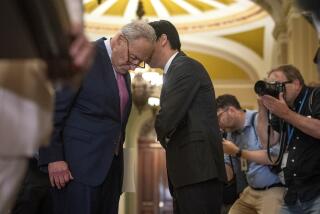Will Ask 19% Hike in Fiscal ’87 Spending : Reagan Seeks to Spur Pentagon’s Research
- Share via
WASHINGTON — President Reagan will ask Congress to approve “a very large” increase--about 19% after inflation--in next year’s Pentagon research budget and a similar increase in military construction, Administration and congressional sources said Thursday.
But the spending plan for fiscal 1986, which Reagan will send to Congress on Monday, will show for the first time in several years only “modest growth” in funding for Pentagon weapons purchases, the sources said.
The increase in research spending stems largely from plans to push ahead with President Reagan’s “Star Wars” missile defense system. Research on that program was given $1.4 billion in the current budget, and the Administration will seek to increase that by $2 billion in the fiscal year that begins Oct. 1, a Pentagon official said.
Pressure From GOP
The defense budget has become a central element in the fight over the Administration’s overall spending plan. Defense Secretary Caspar W. Weinberger, under intense pressure from the Republican majority in the Senate and from other Administration officials, agreed in December to trim the defense buildup by $8.7 billion.
Budget Director David A. Stockman estimated that with such a cut, the Pentagon budget would increase 6.4%, after inflation. Actual defense spending would increase from the current figure of $284.5 billion to $313.7 billion.
A congressional source, speaking on condition he not be identified, characterized the research budget as reflecting the greatest increase in the Pentagon’s major spending areas, and said there will be “very large growth” in that segment.
In the current budget, $21.4 billion is allocated to research. An increase of about 19% would bring the figure to about $26.3 billion, after accounting for an expected 4% inflation rate.
Military construction will show a big increase as work begins on adapting old Minuteman missile silos to the new MX missile, which the Administration hopes to begin deploying in 1986. An Administration official said spending in this area would be “a little bit above 19%, but not too much.”
One non-government defense budget expert who has seen figures prepared by Stockman’s office said spending for strategic and major conventional weapons, which grew from $9.4 billion in 1980 to $35.3 billion in the current year, will climb to $38.1 billion in 1986, reflecting a slower growth rate.
Reagan met Thursday with members of the House Armed Services Committee to plead for support for the MX. Congress is expected to vote in March on funding a second set of 21 missiles.
The vote on the controversial weapon is expected to be the first test this year of congressional sentiment on Reagan’s military buildup and an indication of how his military budget and space-based missile defense system will fare.
‘Our Nuclear Deterrent’
White House spokesman Larry Speakes said Reagan told the House members: “If we cannot make a decision to build 100 missiles (the Administration’s ultimate goal) to restore our aging nuclear deterrent, when they (the Soviets) have deployed over 800 MX-class missiles, there is no incentive for the Soviets in these talks.” Democrats, meanwhile, reacted guardedly to the Administration’s latest budget figures, which they received in a briefing Thursday. The figures were similar to those disclosed by congressional sources in recent weeks and showed that the Administration plans to eliminate general revenue sharing for cities and counties at the end of this fiscal year, a year earlier than originally proposed.
Majority Leader Jim Wright (D-Tex.), said the House Budget Committee plans hearings around the country in February to publicize the spending plan. The hearings appear to be part of a Democratic strategy to avoid an immediate confrontation with Reagan over his budget priorities while trying to stir public opposition to cuts in such programs as student aid and Medicare.
More to Read
Get the L.A. Times Politics newsletter
Deeply reported insights into legislation, politics and policy from Sacramento, Washington and beyond. In your inbox twice per week.
You may occasionally receive promotional content from the Los Angeles Times.







